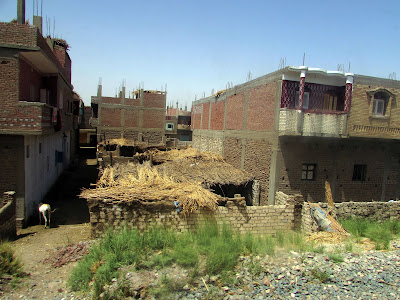We were given a 6:30 a.m. departure time, so after falling into bed at 1 a.m. we rose at 5, packed our bags, and hauled them out to the lobby to wait for Nagy. He arrived soon after with the news that the train would be two hours late, so we might as well have breakfast at our leisure.
This exercise bore similarities to the hurry-up-and-wait drills I remember from ROTC when I was in college -- but soon enough we loaded onto the van for our last police-escorted race to the train station nearby.
I love trains. I know they can be slow, crowded, hot, and uncomfortable; but as an observing and learning opportunity they are hard to beat. They tend to have big windows and they afford opportunity to see parts of towns, cities, and countryside that are otherwise easy to miss.
Under the right train conditions I can give my curiosities free reign. I am interested in landscape, always, and in the raw edges of human habitation exposed alongside tracks. The question is whether I am quick enough to catch what I see in a clear photograph.
Most of the others used the travel time to sleep, which I am not usually able to do because there is so much going on outside the windows. Matt spent quite a bit of time writing in his journal, but I just made occasional notes. I found it hard to write on the train due to rocking and bouncing.
On the other hand, here and there I was privileged to see glimpses of a way of life outside of the big cities. Railroad crossings, for example, are full of new information for the visitor. The yellow, three-wheeled vehicles are a common form of public conveyance -- taxis, if you will. And, of course, always people on foot.

Let me make several observations about these fields. First, they are commonly squared off. If it can be squared off, it is. My first thought was that the squaring was to provide a way to measure, to plan, to control the allotment of ground to crops.
Further observation allowed me to see that the earthen ridges used for squaring allowed farmers to flood one square while leaving the next one dry, thus providing water at crucial times to the growing crops. This had the added benefit of allowing farmers to rotate fields so that one field or another would always be ready to harvest.
Canals fed by the Nile provide a steady supply of water for irrigation in a land with no rainfall.
While I did see a tractor once or twice and a gas powered pump flooding one field, most of the farming appeared to be done with donkeys and by hand, sometimes by whole families out on the fields.
Villages, too, would naturally grow up along the water's edge. The boat here is a ferry for crossing where there is no bridge. A line of some sort has been stretched across the canal and the ferry man pulls the boat from one side to the other. Twice I spotted fishermen in their boats but was not quick enough with my camera to get a photo.
As we slowed for town between Asyut and Luxor we saw a great deal of construction, buildings going up between or near completed apartment buildings.
From time to time, housing for people and housing for farm animals such as donkeys existed side by side in the growing towns. We know these building are still under construction from the bristling rebar rising from nearly every rooftop.
While traditional agriculture appeared to be alive and well, small improvements have made the work easier. Here a donkey pulls a wagon that is outfitted with car tires, which no doubt make both the pulling easier and the ride a bit more comfortable.
When in mid-afternoon we pulled into Luxor, the great city of antiquities and treasures, the first thing that I saw was this church dome with a cross. As I usually am, I was glad I stayed awake for the sights along the way. What an interesting journey!








No comments:
Post a Comment